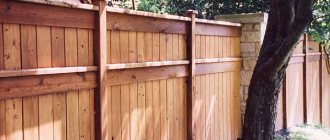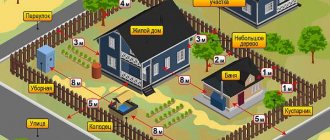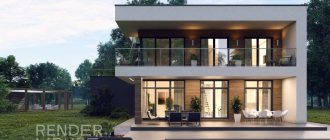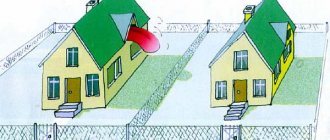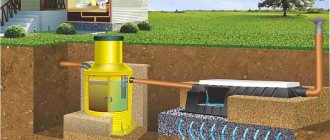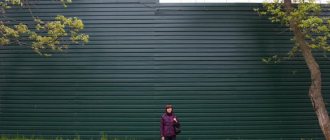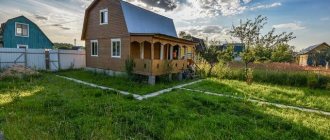The distance from the bathhouse to the neighbor’s fence, as well as other principles of the distance of buildings from fences that cover the yard and delimit private landholdings, are dictated by SNiP. This is a set of norms and rules, developed on the basis of many years of construction experience, which concerns not only individual housing construction, but also more significant options developed for the purpose of selling living space.
In the country
It is possible and necessary to determine the distance from the fence to the bathhouse using SNiP: if neighbors consider their interests to be infringed, and the situation is not environmentally friendly or a fire hazard, they can file a claim. The court's decision will be made in their favor if the construction does not comply with the prescribed standards.
Bathhouse construction and distances
When erecting buildings on your yard, including bathhouses, you should be guided by the technical, legal and urban planning standards enshrined in the provisions:
- on the rules for planning and placing buildings on the territory of a household: SNiP 30-02-97 and SP 53.13330.2019;
- on the requirements, procedure for development and execution of a development project: SP 11-106-97.
Unauthorized buildings or early buildings where the law has been violated pose a threat to neighboring housing developments and can be demolished by court decision. No changes in this regard have been adopted for 2020-2021.
In the village
The Town Planning Code classifies a bath-type building as an auxiliary building.
The purpose of such a facility under construction is associated with an increased danger for surrounding buildings. This is due to the following:
- use of stove heating;
- the likelihood of violations during the installation of the chimney or its untimely maintenance;
- environmental pollution associated with improperly organized wastewater disposal.
SNiP standards define the essence that a well for collecting wastewater and human waste must be located at a distance of at least 8 meters from residential buildings. Its design provides for the possibility of periodic cleaning and maintenance of the collection. Due to non-compliance with this construction norm, conflicts often broke out between neighbors in villages, hamlets and rural settlements.
Sauna
If legal claims arise, knowledge of the provisions of building codes and rules for individual housing construction (IHC), for a dacha non-profit partnership (DNT) and a non-profit garden partnership (SNT) will help resolve the issue of protecting personal interests.
Nuances of determining the optimal distance from the neighboring local area
The owner who was the first to start building his plot has an advantage in choosing the location of buildings and plantings on his plot. In the case where the neighbors' property has already been built up, it is necessary to maintain not only the minimum distance from the boundary, but also the necessary distance from objects installed in the adjacent territory.
The minimum distance from objects installed in adjacent areas should be maintained.
Distance from your home to the border of the neighboring land plot
When creating a building design, it is necessary to take into account the distance of the residential building from both the fence and the neighbor’s home. It should be remembered that the distance is measured from the extreme point of the base, foundation or wall (if there are none) of the building when it does not have a porch, roof slope or decorative elements protruding more than 0.5 m. Otherwise, the distance should be calculated from protruding element of the building. If the owner plans to have a balcony, then the minimum distance to the boundary must be determined from its projection onto the ground.
Setback from buildings to neighbor's fence
When planning the construction of outbuildings and green spaces, one should not forget that:
- tall objects should not obscure the adjacent territory;
- The slope of roofs and awnings must be positioned in such a way as to exclude the possibility of snow falling and water flowing beyond the boundary line.
If conflict situations arise with neighbors due to non-compliance with the rules, the court may order the building to be demolished and impose an administrative fine.
Removing buildings based on material of manufacture
The distance between the main and auxiliary building buildings determined by the standards prevents the transfer of flame to neighboring buildings in the event of a fire. This takes into account the material from which they are made, as well as the possibility of approaching them around the perimeter. That is, at the design stage, any factors that impede the provision of assistance in the event of an emergency are excluded.
Country cottage area
What distance should be between permanent buildings on your own and neighboring plots is indicated in the list below:
- Between stone, cast concrete, prefabricated reinforced concrete – 6 meters.
- The above type, but with floors made of wooden or non-flammable materials - 8 meters.
- Wooden frame buildings with the same fencing can be built at a distance of 15 meters.
- There is 6 meters between the stone fence and buildings with wooden floors.
- From stone fences (for example, brick, bordering frame buildings) - 10 m.
- The boundary between the wooden frame fence and the stone buildings is 6 m.
- From fences with a wooden frame to buildings with a wooden ceiling, the setback is 8 m.
- A fence with a wooden frame should be located 10 m from buildings made entirely of wood.
- The distance to the fence bordering the stone buildings with wood floors is 10 m.
Near the forest
Bathhouse placement standards
There are such standards for the distance of a bathhouse from other objects:
- to residential buildings – 8 m;
- the allowed distance to the street road is 5 m;
- from objects in the manufacture of which non-combustible materials were used, depending on the raw materials (brick garage or barn), a distance of 6–10 m;
- from wooden objects with non-combustible floors – 8–10 m;
- from flammable, entirely wooden buildings – 12–15 m;
- to forests, groves and other places of mass placement of trees – 15 m;
- from lakes, rivers, ponds and the like - 5 m;
- the distance from tall trees, even if it is your own garden, is 4 m;
- medium-sized trees – 3 m;
- shrub vegetation – 1 m.
Regional standards, as a rule, correspond to federal requirements, but it is a good idea to check with the urban planning department of your local government.
On individual housing construction and SNT sites
Recommendations for placing a bathhouse
Planning the placement of buildings on your own site is the right of every owner. At the same time, they must be located so that they are comfortable to use and maintain. But violation of urban planning norms can lead to troubles for the builder and, as a result, the need to establish the truth in court. To prevent such situations, when determining the location for building a bathhouse, it is recommended:
- strictly observe the distance from the fence to the bathhouse, as neighbors may file a complaint with the supervisory authorities;
- comply with sanitary standards and prevent contamination of drinking water sources and locate the sauna no closer than 12 m from the well;
- place the building taking into account the wind rose, since stove smoke should not enter the windows of residential buildings, your own and those of neighbors;
- do not place the bathhouse in a low-lying area, since with such placement it will be flooded in the spring and autumn;
- According to unwritten rules, provide an entrance to the building from the south side. This will speed up the melting of snow in winter and ensure unobstructed passage at any time;
- if it is impossible to fully comply with the requirements for the distance to a neighboring garden, you can agree with the owner of a private house located nearby to reduce the distance;
- If there are doubts about the validity of the information about the requirements for the location of a sauna in a particular region, then you should check with the local government at what distance objects can be built from the fence and neighboring buildings and what risks are associated with the construction of the structure.
Neighborhood agreements will have legal force if they are certified by a notary in the manner prescribed by law.
They will act in relation to the owner who signed the agreement, and his change will entail the need to renew the agreement with the new owner.
Norms of distances from the fence on individual housing construction and SNT sites
New registration rules
On March 1, 2021, new property registration rules enshrined in Law No. 340-FZ came into force. Capital construction can be legalized only after the construction (planned or completed) has been approved by the local administration. If construction work has not been completed by March 1, 2021, it is mandatory to notify local authorities.
Permits will have to be obtained if the bathhouse is combined with a cottage or other residential building. If it is planned to build a commercial bathhouse on the site, its registration is also mandatory.
Fire safety requirements
Increased requirements for objects with stove heating are justified. Due to violations of fire safety rules, fires occur in bathhouse buildings everywhere, and many people are poisoned by carbon monoxide. To prevent such events it is necessary:
- At the design stage, provide a distance between the bathhouse and buildings outside the boundaries of the site in accordance with SNiP standards. It is also necessary to familiarize yourself with the additional requirements that the gardening partnership may impose. This will prevent the fire from spreading to the neighboring property if the property catches fire.
- To build a stove and organize a chimney, invite an experienced stove maker who will calculate the dimensions of the firebox required for a particular structure, the height of the gas exhaust pipe, and also provide for the possibility of limiting the rise of the flame and the likelihood of reverse draft.
- Before the firebox, it is necessary to place a metal sheet to prevent fire when ash and burning brands fall out of the firebox.
- Where the pipe passes through the ceiling, a thermal seal must be installed - direct contact can lead to overheating of wooden structures and their fire.
- The effectiveness of clearing the room from carbon monoxide in case of critical situations depends on the organization of the ventilation system. It must be built reliably, using new technologies.
Rules and regulations
A home bath must be fully equipped with fire extinguishing equipment. Accessories are placed in a convenient place accessible to visitors. During direct use, the entrance door should not be locked.
Project and its approval
The construction of a bathhouse or any other building in DNT or SNT, if it is built on a foundation, has a non-commercial purpose and must be carried out after obtaining permission from the architectural departments of local governments. Otherwise, it will be considered unauthorized construction, and it will not be possible to enter it into the state real estate cadastre retroactively, for example for 2021.
In the steam room
To obtain a construction permit, you must submit the following set of documents:
- statement, taking into account office work standards in the region;
- documents confirming the identity of the owner of the housing construction;
- documents evidencing the applicant’s right to carry out legal actions in relation to the land plot, the purpose of which is horticultural or other;
- topographical diagram linking the territory where construction is planned to the general plan of the settlement, with distances to the neighbor’s fence;
- cadastral plan of the site with dimensions in square meters or in acres and designation of how the land of the site is tied to the area;
- real estate assessment carried out by BTI;
- plan for the placement of communications on the site with points of connection to city utility networks;
- drawing of a new building on a summer cottage.
Distance to road
If it is planned to involve specialized companies for the construction of a bathhouse, then their specialists must undertake the preparation and approval of documentation.
This service is provided on a paid basis.
The video talks about the standard distances between buildings on sites in SNT and individual housing construction in accordance with Russian legislation.
To register or not to register?
In Russia today, legislation simultaneously affects several branches of law, answering the question of whether it is necessary to register a bathhouse. It is important to take into account the requirements of housing, civil, tax, and land legislation relevant in 2021. In accordance with Art. 131 of the Civil Code of the Russian Federation, real estate requires mandatory state registration . But it is also worth considering that the bathhouse can be considered as:
- Temporary building. In this case, registration is not required.
- Real estate. Registration is required.
The difficulty is that it is difficult to determine what signs a bathhouse has. According to Art. 130 of the Civil Code of the Russian Federation, there are 2 main characteristics of real estate:
- Inextricably linked to the earth.
- Cannot be separated from the soil without causing great damage.
In other words, if the building is not temporary, it has a foundation, communications are connected, there are strong supporting structures, registration is required. In most cases, a bathhouse on the site must be registered.
Project requirements
The project is drawn up in strict accordance with the requirements for drawing up architectural documentation, which have not changed since 2015. It should include:
- Description and purpose of the building. It is planned to install a one- or two-story structure at a dacha in a village or on a garden plot.
- The exact dimensions of the building along the perimeter, the location of the rooms inside, with a schematic indication of window and door openings. Including height, width, length of all rooms.
- How much and what materials will be used.
- Type of steam room - sauna with dry steam or Russian bath.
- Heating system. If electric heat sources are assumed, then indicate the estimated amount of electrical energy consumed.
- The meaning and material of finishing of accompanying premises.
- Methods for supplying water and draining wastewater. Places of connection to city communications.
- The procedure for ventilation of the room.
Bathhouse next to the fence
Without special knowledge, it is difficult to prepare a project on your own. In this regard, having determined the list of wishes, it is necessary to seek help from professionals.
Package of documents
To register a bathhouse on your own site, you will need to collect a package of documents. It includes:
- Application of the established form indicating the address where the building will be located.
- Documents certifying ownership of the plot (extract from the Unified State Register of Real Estate, certificate of title, contract).
- Passport of the owner (representative of the owner and power of attorney) or other identification document.
- Boundary plan of the land plot.
- Construction permit.
- Project documentation. The document specifies the necessary technical information (dimensions, number of premises, building materials, heating equipment and other categories of construction).
- List, location of utilities that are suitable for the building. Scheme, type, location of wastewater disposal systems, drainage system.
- Receipts for payment of state fees.

